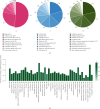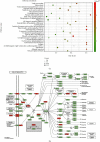TMT-Based Quantitative Proteomic Analysis Identification of Integrin Alpha 3 and Integrin Alpha 5 as Novel Biomarkers in Pathogenesis of Acute Aortic Dissection
- PMID: 32851057
- PMCID: PMC7441460
- DOI: 10.1155/2020/1068402
TMT-Based Quantitative Proteomic Analysis Identification of Integrin Alpha 3 and Integrin Alpha 5 as Novel Biomarkers in Pathogenesis of Acute Aortic Dissection
Abstract
Background: Acute aortic dissection (AAD) is a devastating cardiovascular disease with a high rate of disability and mortality. This disease often rapidly progresses to fatal multiple organ hypoperfusion, and the incidence has been increasing in recent years. However, the molecular mechanisms have yet to be clarified. This study is aimed at identifying the differential abundance proteins (DAPs) of aortic arch tissues in patients with AAD by proteomics and select possible proteins involved in AAD pathogenesis.
Methods: The fresh aortic arch tissues obtained from 5 AAD patients and 1 healthy donor were analyzed by amine-reactive tandem mass tag (TMT) labelling and mass spectrometry; then, the pathological sections of another 10 healthy donors and 20 AAD patients were chosen to verify the proteomic results by immunohistochemistry.
Results: Of 809 proteins identified by proteomic analysis, 132 differential abundance proteins (DAPs) were screened, of which 100 proteins were significantly downregulated while 32 upregulated. Among 100 downregulated proteins, two proteins with known function, integrin alpha 3 (ITGA-3) and ITGA-5, were selected as target proteins involved in AAD pathogenesis. Two target DAPs were verified by immunohistochemisty, and the results showed that the integrated option density (IOD) of ITGA-3 and ITGA-5 in AAD patients was significantly lower than that in healthy donors, which were consistent with the proteomic results (P < 0.001).
Conclusion: ITGA-3 and ITGA-5 represent novel biomarkers for the pathogenesis of AAD and might be a therapeutic target in the future.
Copyright © 2020 Lingyu Xing et al.
Conflict of interest statement
The authors declare that there is no conflict of interest regarding the publication of this article.
Figures






Similar articles
-
Tandem mass tag-based quantitative proteomic analysis identification of succinylation related proteins in pathogenesis of thoracic aortic aneurysm and aortic dissection.PeerJ. 2023 May 11;11:e15258. doi: 10.7717/peerj.15258. eCollection 2023. PeerJ. 2023. PMID: 37193023 Free PMC article.
-
Integrin α9 is involved in the pathopoiesis of acute aortic dissection via mediating phenotype switch of vascular smooth muscle cell.Biochem Biophys Res Commun. 2020 Dec 10;533(3):519-525. doi: 10.1016/j.bbrc.2020.08.095. Epub 2020 Sep 25. Biochem Biophys Res Commun. 2020. PMID: 32981677
-
Serum Proteomics Analysis of Patients with Ascending Aortic Dilation.Cardiovasc Toxicol. 2025 May;25(5):750-761. doi: 10.1007/s12012-025-09991-5. Epub 2025 Apr 1. Cardiovasc Toxicol. 2025. PMID: 40169515
-
Identification of candidate biomarkers of acute aortic dissection.Recent Pat DNA Gene Seq. 2008;2(1):61-5. doi: 10.2174/187221508783406567. Recent Pat DNA Gene Seq. 2008. PMID: 19075946 Review.
-
[The molecular mechanisms contributing to the pathophysiology of systemic inflammatory response after acute aortic dissection].Nihon Rinsho Meneki Gakkai Kaishi. 2016;39(2):91-5. doi: 10.2177/jsci.39.91. Nihon Rinsho Meneki Gakkai Kaishi. 2016. PMID: 27212594 Review. Japanese.
Cited by
-
Is There Enough Evidence to Support the Role of Glycosaminoglycans and Proteoglycans in Thoracic Aortic Aneurysm and Dissection?-A Systematic Review.Int J Mol Sci. 2022 Aug 16;23(16):9200. doi: 10.3390/ijms23169200. Int J Mol Sci. 2022. PMID: 36012466 Free PMC article.
-
Establishment of a nomogram model based on immune-related genes using machine learning for aortic dissection diagnosis and immunomodulation assessment.Int J Med Sci. 2025 Jan 21;22(4):873-886. doi: 10.7150/ijms.100572. eCollection 2025. Int J Med Sci. 2025. PMID: 39991758 Free PMC article.
-
Machine learning and 4D-LFQ quantitative proteomic analysis explore the molecular mechanism of kidney stone formation.Heliyon. 2024 Jul 10;10(14):e34405. doi: 10.1016/j.heliyon.2024.e34405. eCollection 2024 Jul 30. Heliyon. 2024. PMID: 39114033 Free PMC article.
-
Applying multi-omics techniques to the discovery of biomarkers for acute aortic dissection.Front Cardiovasc Med. 2022 Dec 15;9:961991. doi: 10.3389/fcvm.2022.961991. eCollection 2022. Front Cardiovasc Med. 2022. PMID: 36588568 Free PMC article. Review.
-
Tandem mass tag-based quantitative proteomic analysis identification of succinylation related proteins in pathogenesis of thoracic aortic aneurysm and aortic dissection.PeerJ. 2023 May 11;11:e15258. doi: 10.7717/peerj.15258. eCollection 2023. PeerJ. 2023. PMID: 37193023 Free PMC article.
References
-
- He R., Guo D. C., Estrera A. L., et al. Characterization of the inflammatory and apoptotic cells in the aortas of patients with ascending thoracic aortic aneurysms and dissections. The Journal of Thoracic and Cardiovascular Surgery. 2006;131(3):671–678.e2. doi: 10.1016/j.jtcvs.2005.09.018. - DOI - PubMed
MeSH terms
Substances
LinkOut - more resources
Full Text Sources
Other Literature Sources
Medical
Miscellaneous

